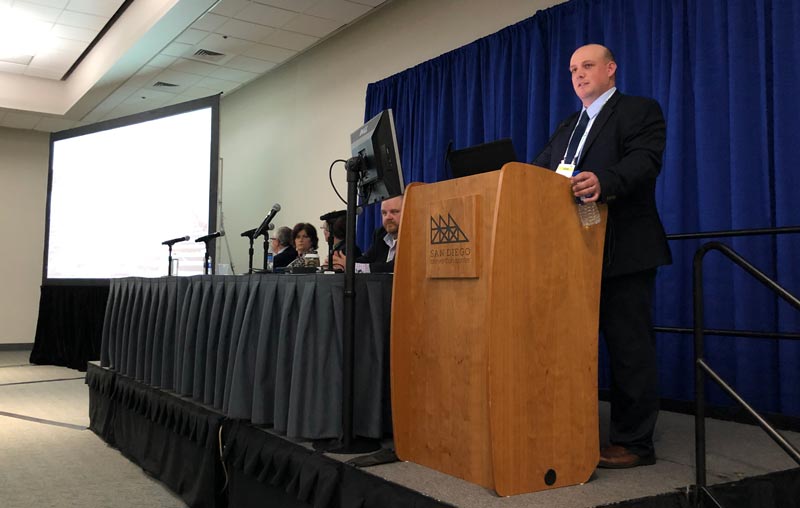
Superintendent Tyler Bloom takes the podium to kick off “Why Didn’t I Think of That? Ideas That Make an Impact” on Feb. 4 at the Golf Industry Show in San Diego. Photo by Roger Billings
Eighty-seven percent. That’s the employee retention rate at a Maryland club where, just four years ago, the superintendent was struggling with a turnover rate of 50 to 75 percent.
2011. That was the last time a Florida superintendent had to pay a power bill for his maintenance facility.
Forty-nine percent. That’s how much of their allotted vacation time the average American worker forfeits.
Numbers helped tell the stories during “Why Didn’t I Think of That? Ideas That Make an Impact” on Monday morning at the 2019 Golf Industry Show in San Diego. Moderated by 19-year GCSAA member Zach Bauer, superintendent at Valley Country Club in Centennial, Colo., the two-hour free session offered attendees the opportunity to hear from five panelists with experience and expertise in tackling challenges and taking on new initiatives.
First up was Tyler Bloom, director of grounds and facilities at Sparrows Point Country Club in Baltimore, who spoke about improving staff retention by building a relationship-based work culture. Some of the tactics the nine-year GCSAA member touched on were defining expectations, generating curiosity and instilling ownership. Thinking outside the box and embracing diversity have benefited Bloom’s labor force — he offers an internship for high school students and has teamed up with a job placement firm for people with disabilities.
Paul Roche, principal of Golf Water, a golf course irrigation design and consulting firm based in Wake Forest, N.C., highlighted tips and tricks he has picked up from his stops at various golf courses. These included insights on everything from measuring salinity and sediment to ensuring clean backfill during irrigation system installation. Roche’s lineup of bright ideas featured many to easy, low-cost actions, such as assembling a simple $25 kit to gauge water distribution, disguising a rain can in a hollowed-out birdhouse with mesh on the top, and marking valve access boxes with bright-colored plastic “whiskers.” And don’t forget to take into account sprinkler tilt’s impact on distribution uniformity.
Next, Terry Buchen, CGCS Retired, MG, gave those in attendance a rundown of short- and long-term considerations regarding their golf facility’s infrastructure. Buchen, president and consulting agronomist with Golf Agronomy International LLC, brought to life his 2017 GCM article Assessing golf course infrastructure, in which he included a handy chart detailing the life expectancies of various golf course infrastructure components. The 50-year GCSAA member blended his technical talk with several quick bits of wisdom. For instance, Buchen said bunkers wear out faster than any other part of the golf course, and that he can’t recommend enough that turf managers establish an annual sand topdressing program.
Lisa Goatley, a licensed professional counselor with the Cascade Group, based in Blacksburg, Va., presented tips for reducing stress and avoiding burnout. Among the stress-curbing strategies recommended and discussed were unplugging from tech, setting priorities, refraining from multitasking, and resurrecting an old hobby or finding a new one. Goatley added that while some in today’s workforce view forgoing their vacation days as a badge of honor, in her opinion, such a practice is a recipe for burnout.

Photo by Laura Pratt/Unsplash
The final speaker was Andrew Jorgensen, CGCS, golf course superintendent at On Top of the World Communities in Ocala, Fla. Jorgensen took attendees through his facility’s foray into solar power, detailing its multiple merits (sustainability, locked-in energy prices) and offering advice for fellow superintendents looking to tap this renewable energy source. The 19-year GCSAA member installed 297 190-watt panels on one of his maintenance facilities in 2011, and the setup meets 118 percent of the facility’s needs. The return on investment is 12 years.
Jorgensen said solar panels are particularly well suited for golf course maintenance facilities because the buildings tend to be out of sight (in case some people object to the look of the panels), the roofs are large have minimal obstructions (such as vents or exhaust fans), and, with more electric mowers, rollers and other equipment on the market, there’s more to plug in in the shop than ever before.
Megan Hirt is the editor of GCMOnline.com.